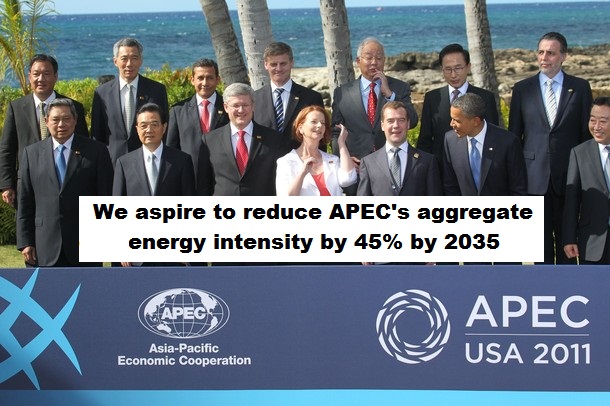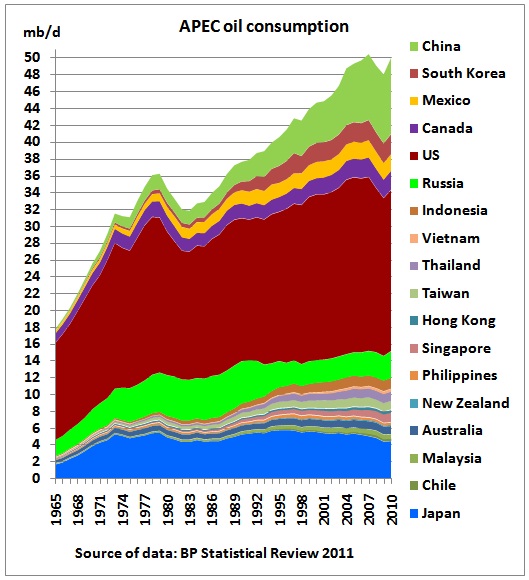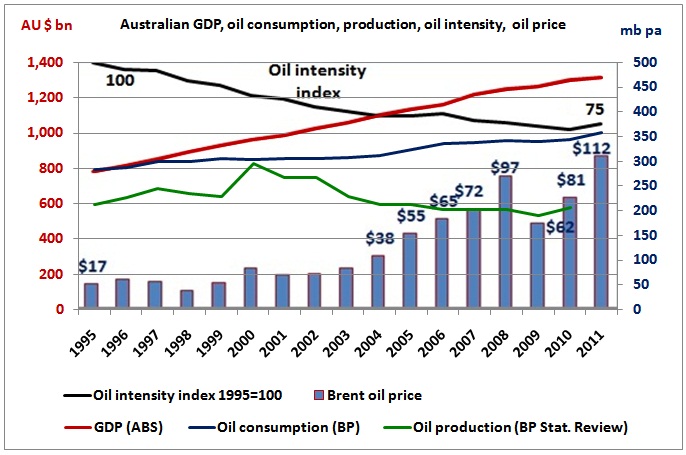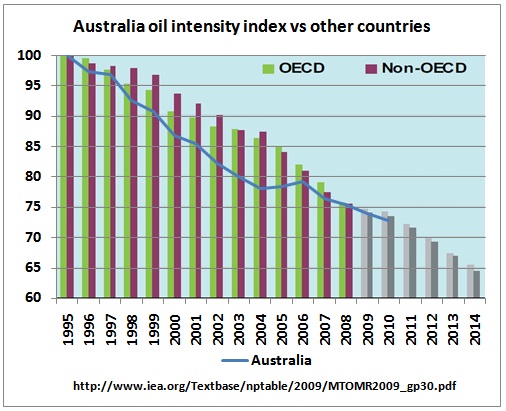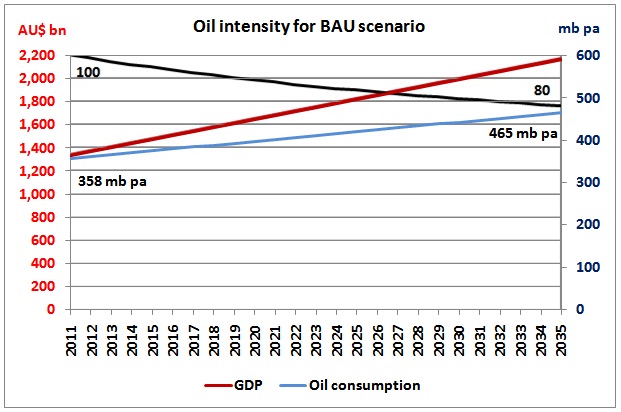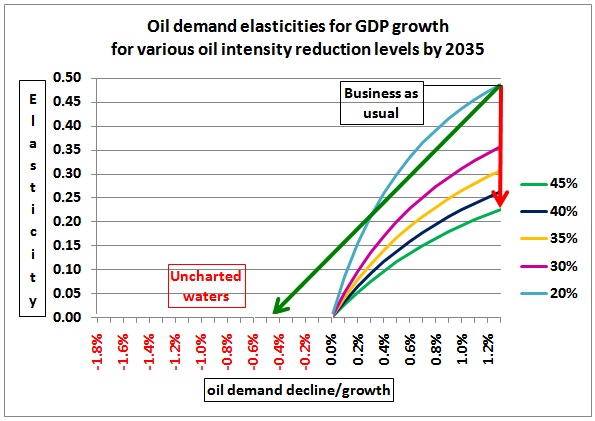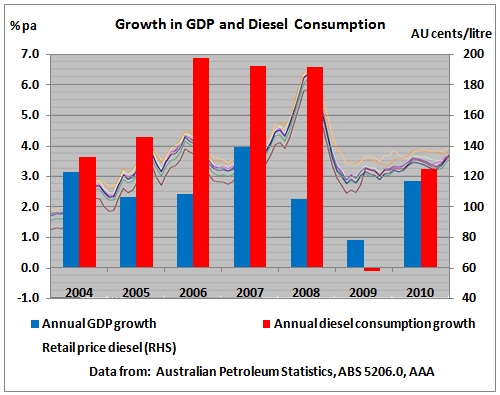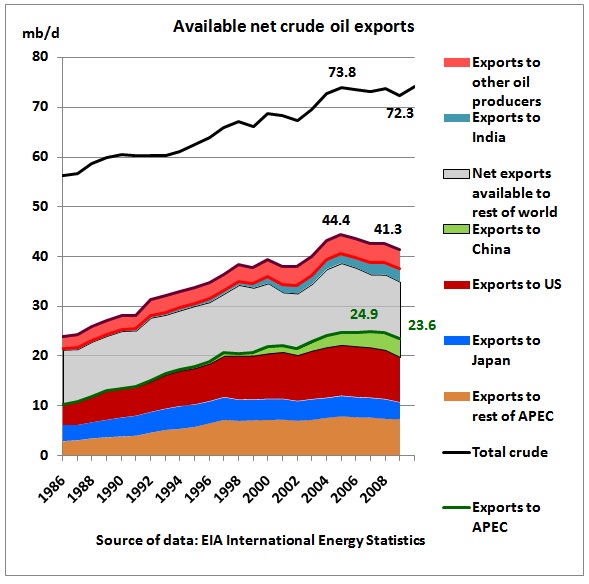At the APEC summit in November 2011 we find in the Honolulu declaration under “Promoting green growth”:
We will also take the following steps to promote our green growth goals:
- Aspire to reduce APEC’s aggregate energy intensity by 45 percent by 2035;
http://www.apec.org/Press/News-Releases/2011/~/link.aspx?_id=F5D8AB2B402A41019C8CDAF6090B6D01&_z=z
Let’s see whether this “aspiration” is achievable in relation to oil and what it means.
(1) The context of APEC’s oil consumption and production
 We see that APEC oil consumption has been growing up to 2007 to around 50 mb/d and that – except for Russia – APEC oil production has been flat since the early 80s. The 1st peak was caused by the peaking in the West Siberian oil fields, followed by the collapse of the Soviet Union. The 2nd and last Russian peak is on right now, by using Western technology. Current APEC net oil import requirements are around 19 mb/d. It is also to be noted that the APEC group by no means forms a common oil market. As a lot of Russian oil flows towards Europe, net oil import requirements would be higher. So it is clear there is a problem since everyone expects Asia to grow. The Australian Prime Minister even talks of:
We see that APEC oil consumption has been growing up to 2007 to around 50 mb/d and that – except for Russia – APEC oil production has been flat since the early 80s. The 1st peak was caused by the peaking in the West Siberian oil fields, followed by the collapse of the Soviet Union. The 2nd and last Russian peak is on right now, by using Western technology. Current APEC net oil import requirements are around 19 mb/d. It is also to be noted that the APEC group by no means forms a common oil market. As a lot of Russian oil flows towards Europe, net oil import requirements would be higher. So it is clear there is a problem since everyone expects Asia to grow. The Australian Prime Minister even talks of:
Gillard hails “Asian Century” as ASEAN begins
http://www.abc.net.au/news/2011-11-19/gillard-hails-asian-century-as-asean-begins/3681574
We analyse the Australian situation
(2) Australia’s past performance
In this graph we look at GDP, oil consumption, oil production, oil intensity and oil prices.
GDP data from here: http://www.abs.gov.au/ausstats/abs@.nsf/Products/363703EE2145C62CCA25791A001450A5?opendocument
Oil intensity = oil consumption divided by GDP [barrels per $ 1,000 GDP]
This is an abstract term and it is best put in an index which we start arbitrarily with 100 in 1995. Figures for 2011 are estimated.
What we see on the above graph:
- Both GDP and oil consumption grew continuously, irrespective of Brent oil prices
- Australian oil production peaked in 2000 but did not increase with higher oil prices resulting in more oil imports
- While GDP grew at an average of 4.3 % pa oil consumption increased by only 1.6% pa. Therefore, the oil demand elasticity of GDP growth is 1.6/4.3 = 0.37, that is for every percentage point of GDP growth oil demand increases by 0.37% pa.
- For the high oil price period 2004-2011 (after peak oil started) the GDP growth slowed down to 2.8% but oil consumption went up 2% suggesting an elasticity of 2/2.8 = 0.74%. This is the opposite trend of what one would expect when oil prices more than double. The higher Australian dollar may have contributed to insulate the transport sector from international oil price pressures.
- The oil intensity defined as oil consumption per GDP declined by around 25% in 16 years. This trend did not accelerate with higher oil prices. In the contrary, the curve was rather bottoming out. This means oil prices would have to go much, much higher to have a larger impact on oil intensity.
Population growth in the period was 1.6% pa
(3) Comparison with other countries
http://www.iea.org/Textbase/nptable/2009/MTOMR2009_gp30.pdf
After a good performance (a lower oil intensity can be achieved by a higher GDP and a flat oil consumption) Australia fell back to about average by 2010.
(4) Can we make it?
Let’s continue business-as-usual with simplified assumptions (+$35 billion GDP pa and +4.7 mb pa)
Oil intensity with this type of growth would go down by 20%, not 45%.
Let’s see how we could achieve this. There are many combinations of GDP and oil consumption growth/decline. This is the solution space:
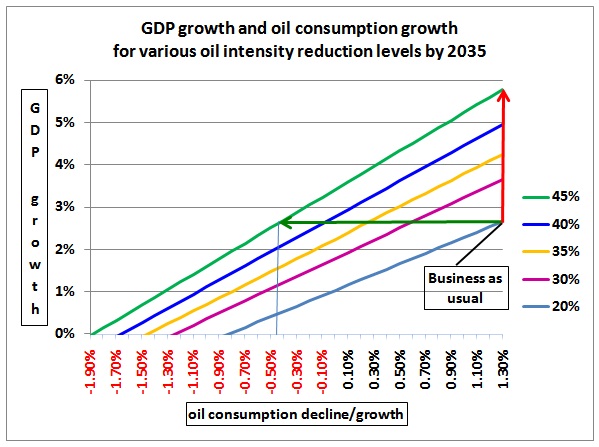 The formula for the above set of lines is:
The formula for the above set of lines is:
GDP growth =((1+oil consumption growth x 24 years)/(1-reduction level)-1)/ 24 years
How do we get away from the business as usual point (linear oil consumption growth 1.3% , linear GDP growth 2.6%) in this graph? These are examples:
(a) With a continuation of oil consumption growth, the GDP would need to grow by 5.8% pa (red arrow)
(b) If only a GDP growth as in the past 15 years can be achieved, oil consumption would need to go down by -0.45% pa (green arrow). That’s how it would look like:
(5) Oil demand elasticity
Oil demand elasticity of GDP growth = change in oil consumption divided by change in GDP. In other words: how much oil consumption growth is needed for 1% in GDP growth.
For the 2 scenarios discussed above:
(a) For a very high GDP growth, oil demand elasticity would need to halve (red arrow)
(b) For a GDP growth similar to what was achievable since 2004 oil demand elasticity would need to go into negative territory, that means a complete disconnect between GDP growth and oil consumption growth
And that will be a very tough job. The above graphs are quite theoretical and assume smooth transitions. But this is not the case in every year or period. This is an example:
Between 2004 and 2010, except for 2009, diesel consumption growth was higher than GDP growth. That gives us an idea how hard it will be to reduce oil intensity.
(6) Relevance of APEC aspiration
The period until 2035 has been conveniently chosen to be sufficiently far away so that no one gets worried too much about any changes in the near future. So that’s why it can be just an “aspiration”.
What’s more, from the above graphs we can see that a reduction in oil intensity does not necessarily mean a reduction in oil consumption. If GDP increased by 100*(1/(1-0.45)-1)=82%, equal to 3.4% pa over 24 years, then oil consumption could theoretically stay flat to achieve a 45% reduction in oil intensity. The notion of perpetual economic growth could be maintained. In so far this aspiration has nothing to do with green growth.
(7) Adequacy of APEC aspiration
The problem is, however, that crude oil production has started to peak in 2005. In its latest WEO 2011, the International Energy Agency IEA writes:
Crude oil supply increases marginally to a plateau of around 69 mb/d (just below the historic high of 70 mb/d in 2008) and then declines slightly to around 68 mb/d by 2035. Nonetheless, gross capacity additions of 47 mb/d – twice current OPEC Middle East production – are needed just to compensate for declining production at existing fields. Non-OPEC production falls marginally, while OPEC’s market share expands from 42% in 2010 to 51% in 2035. Increasing reliance on imports in the importing non-OECD regions, notably Asia, will inevitably heighten concerns about the cost of imports and supply security.
http://www.iea.org/weo/docs/weo2011/factsheets.pdf
This of course was known since the WEO 2008. See Fig 11.1 page 250
http://www.iea.org/weo/2008.asp
A basically flat crude oil production means declining crude oil exports:
In this graph we see that crude oil exports to APEC countries have already peaked in 2007 at around 25 mb/d.
How will that continue in the next 10 years?
 http://www.theoildrum.com/node/8573#comment-848957
http://www.theoildrum.com/node/8573#comment-848957
This graph is from petroleum geologist Jeff Brown shown at the recent ASPO conference “Truth in Energy”.
http://aspo-usa.com/conference/2011/
He estimates that available net oil exports from the top 33 producers to the rest of the world will decline by 5.1 % pa while exports to Chindia could increase by 7.5% pa (at the rate of 60/40 to China/India). Since China is part of APEC, the resulting decline rate for APEC would be 3.5% pa over the next 10 years. This is substantially more than the scenario 5b contemplated above.
So there will be big fights about declining global crude oil export volumes. Therefore the loosely defined “aspiration” for 2035 will in the next years turn into a dead serious and more ambitious target for 2020, much earlier than many of the APEC participants would have imagined.
This situation will get even worse if crude oil production starts to decline as estimated by Prof. Aleklett
17/5/2011 ASPO: 2020 crude oil production down by around 8 mb/d
http://crudeoilpeak.info/aspo-2020-crude-oil-production-down-by-around-8-mbd
(8) Plans to be revised
Practically all State and Federal transport, urban and regional plans would have to be changed immediately.
Here are 3 examples:
(a) Infrastructure Australia: Major Cities Unit
In the recently published report “State of Australian Cities” (Oct 2011) a perpetual freight traffic growth graph from BITRE has been included which would need to be revised in light of the APEC aspiration.
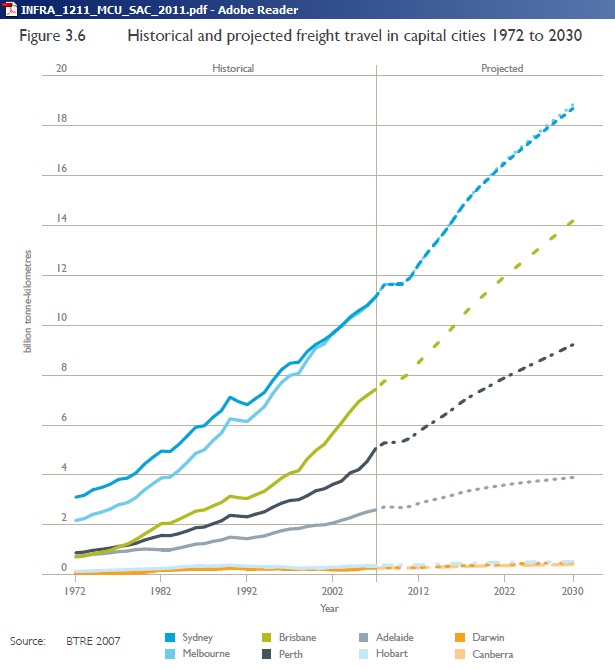 http://www.infrastructure.gov.au/infrastructure/mcu/soac.aspx
http://www.infrastructure.gov.au/infrastructure/mcu/soac.aspx
In all likelihood the physics of declining oil exports will force a re-think, rather than the APEC aspirations.
(b) Metropolitan Strategy Sydney
Part of the Metropolitan Plan for Sydney 2036 http://www.metrostrategy.nsw.gov.au/
is the Barangaroo development, a new financial centre (amidst the worst financial crisis the world has seen since WW2 ! ):
http://www.barangaroo.com/news-media/news/15-nov-2011-c3-and-c5-on-public-exhibition.aspx
While this article is about oil intensity, the APEC 2011 declaration was more generally about energy intensity. So what is the energy intensity of this skyscraper project? In terms of embedded energy per investment dollar and in terms of continuing energy consumption per annual operational cost? No one has calculated that.
Cities with a low energy intensity would not be bigger than around 150,000 as shown in this post:
26/8/2009 Sustainable Cities Master Plan
http://crudeoilpeak.info/sustainable-cities-master-plan
(c) Population strategy and immigration
The Federal government’s “Sustainable population Strategy for Australia” can be found here:
http://www.environment.gov.au/sustainability/population/publications/strategy.html
Much of the above mentioned population growth is caused by immigration. Its share can be as high as 65% (page 14 in the Government’s population strategy document 2011).
http://www.environment.gov.au/sustainability/population/publications/pubs/population-strategy.pdf
Although the document avoids to define a population target for political reasons (see box 3 on page 24) the Federal government is nonetheless running an aggressive immigration program with the objective of promoting economic growth and possibly avoiding a crash in the housing market of capital cities.
While Treasury’s intergenerational report 2007 predicted a population of 27.1 million in 2037
http://www.treasury.gov.au/documents/1239/HTML/docshell.asp?URL=03_Part_2.htm
3 years later the 2010 report came out with a population of 29.2 million in 2030 and 32.6 million in 2040
http://www.treasury.gov.au/igr/igr2010/Overview/html/overview_05.htm
As natural population growth projections cannot change that much in just 3 years, the higher projection is driven by immigration.
Given the link between population growth, GDP and energy consumption it must now be reviewed what impact immigration has on energy intensity. 83% of migrants (page 16) settle in capital cities which run at high energy intensities. That cannot continue.
Further reading on this topic:
9/4/2010 Australian Population Scenarios in the context of oil decline and global warming
Conclusion:
There is no way we can continue business as usual on current trends. The APEC 2011 aspiration to reduce energy and therefore oil intensity by 45% by 2035 will soon become a serious challenge, much earlier than most think. The 1st task now is to review all budget papers, government and corporate strategies and plans with the objective to implement a reduction in energy intensity. All projects which are not in line with this objective will fail and become a future burden.
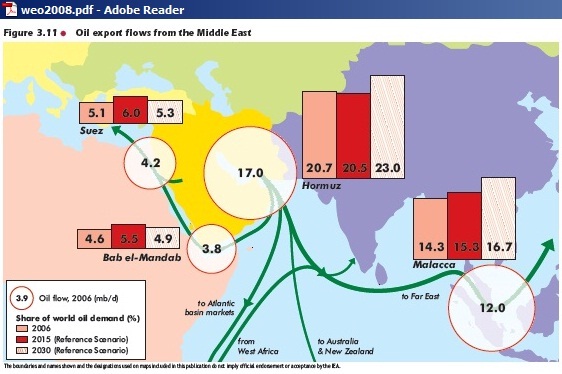
From the WEO 2008: Vulnerability of the Asia-Pacific region to oil supply disruptions from the Middle East.
